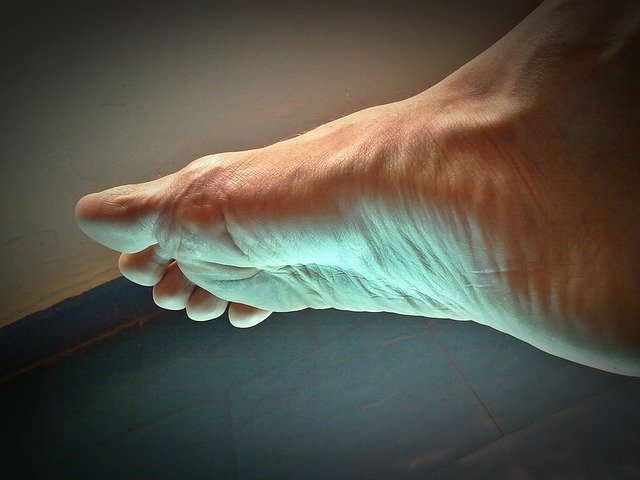Diagnosis and Treatment of Hammer Toe in Wake County

What is a Hammer Toe?
A hammer toe is a deformity of the second, third, or fourth toes that causes them to bend or curl downward instead of pointing forward. In those with this condition, the toe is bent at the middle joint (proximal interphalangeal joint), so that it resembles a hammer. A hammer toe may be present at birth; however, it usually develops over time due to arthritis or wearing ill-fitting shoes, such as tight, pointed heels. Typically, hammer toes are flexible and can be corrected with simple measures. However, if the affected toes are left untreated, they can become stiff and require surgery.

Causes of Hammer Toe
Muscles work in pairs to strengthen and bend the toes. If the toe is bent in one position long enough, the muscles and joints tighten and cannot stretch out. Hammer toe is the result of a muscle imbalance that leads to increased pressure on the toe tendons and joints. Common causes of hammer toe include:
- A toe injury
- Arthritis
- Wearing shoes that don’t fit properly
- High arches
- Pressure from a bunion
Symptoms of Hammer Toe
A hammer toe causes significant pain and discomfort, especially when you walk or try to stretch or move the affected toe. Other symptoms may include:
- Swelling or redness
- Inability to straighten the toe
- Difficulty walking
- A corn or callus on the top of the middle joint of the toe or on the tip of the toe
How is Hammer Toe Diagnosed?
Your Raleigh Orthopaedic physician will be able to diagnose a hammer toe during a physical examination. Imaging tests, such as an X-ray, may be necessary if you’ve had a bone, muscle, or ligament injury in your toe. Patients who have diabetes or decreased sensation in their feet may require further testing to determine whether a neurological condition is the cause of the tendon imbalance.

Treatment Options for Hammer Toe at Raleigh Orthopaedic
Before considering surgery for hammer toe, your doctor will discuss nonsurgical treatment options with you. Nonsurgical options are normally pursued for those who are still able to flex their affected toe. These techniques include:
- Changes in footwear. Avoid wearing tight, narrow, high-heeled shoes. Shoes should be one-half inch longer than your longest toe – which for many people is the second toe.
- Exercises. Specific exercises can help stretch and strengthen the muscles in your foot, such as gently stretching your toes manually or using your toes to pick things up off the floor.
- Over-the-counter remedies. Using straps, cushions, or non-medicated corn pads can help relieve pain.
If you’re unable to flex your toe, surgery is the only option to restore movement. Surgery is typically performed on an outpatient basis using a local anesthetic. The type of procedure you receive will depend on the type and extent of the deformity.
- Fusion: This is the most common surgical procedure for hammer toes. Both ends of the bone at the fixed joint are cut, and a pin, or K-wire, is temporarily inserted to keep the toe straight. Once the ends fuse, the pin is removed. A newer technique involves a rod or screw that is permanently implanted.
- Tendon transfer: Tendon transfer can be used for patients with a flexible toe joint. The procedure involves transferring tendons from the bottom of the toe to the top, pulling the joint into a straight position.
- Joint resection: An incision is made on the top part of the toe, and then the end of the bone at the fixed joint is removed. Small metal pins or rods are often used to keep the toe straight during healing. The pins are usually removed a month or so after surgery.

Recovery from Hammer Toe Surgery
After surgery, you may experience some stiffness, swelling, and redness in your toe for 4 to 6 weeks. You should try to keep your foot elevated as often as you can to take pressure off the toe. Be sure to ask your Raleigh Orthopaedic surgeon about any restrictions on driving or other activities while your toe heals. Once fully healed, your toe may be slightly longer or shorter than it was before.
How Can I Prevent Hammer Toe?
One of the best ways to prevent hammer toe is to wear comfortable shoes. The best shoes to wear offer support and have a wide space for the toes. Pumice stones are also very effective in wearing down the corns and calluses that form on top of a hammer toe. It is recommended to do this after a warm bath and apply ointment to keep the area soft. Foot exercises can also help strengthen toe muscles and prevent hammer toe. This workout can be as simple as curling and extending the toes repeatedly.

Hammer Toe Treatment at Raleigh Orthopaedic
If you are experiencing symptoms of hammer toe, Raleigh Orthopaedic has foot and ankle specialists who are committed to helping you achieve a full and speedy recovery. Once we’ve examined your injury or condition, we will create a personalized treatment plan and answer any questions you may have about your treatment options. To schedule an appointment at one of our clinics in Wake County, please contact us today.




